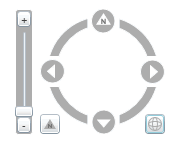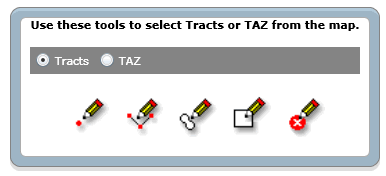Help
Help File Index
Introduction
Transferability refers to the transferability of the 2001 Nationwide Household
Travel Survey (NHTS) results to the regional or local level. Transferability is
a methodology for using the NHTS data to estimate regional or local travel,
including vehicle trips (VT), vehicle miles of travel (VMT), person trips (PT),
and person miles of travel (PMT) by trip purposes. The resulting data can be
used by transportation planners and analysts in their transportation planning
process. See the report Transferring 2001
National Household Travel Survey for additional information.
The NHTS Transferability tools allow users to download trip generation rate
information for selected Census Tracts and Transportation Analysis Zones (TAZ).
Output Transferability Datasets
Output datasets are in Microsoft Excel XML format compatible with Microsoft Office 2003 and above.
There are examples in the NHTS Data Center for
Tracts and
TAZs.
If your Web browser is IE and you have Excel installed, then usually the
spreadsheet will automatically open in Excel. If using a different browser, then
right-click on the link to save it to a local file and then open it with Excel.
Transferability Tool Options
There are two tool options:
- Select by map (sorry, the map server is out of
operation; we are working to restore this feature)
- Select using menus of state and county
Map Navigation (sorry, the map server is out of
operation; we are working to restore this feature)
Use the Zoom and Pan tools to identify the area that frames the Tracts or TAZs of interest.
Also, you can use a mouse wheel to zoom and mouse drag to pan.

Click on the layer radio buttons to choose between Tracts and TAZ.

Selecting Tracts and TAZs (sorry, the map server is out of
operation; we are working to restore this feature)

Selections are made by point, line, polygon, or rectangle. For point and line
selections, terminate the selection with a double-click.
Selected Tract or TAZ IDs are shown in the table.
You can add to your selections but there is no way to remove a selection. Each
time you make a selection you must first click on the selection tool to be used.
Also, you can clear your selections (right-most tool with the red 'X').
Creating Datasets for Selected Tracts and TAZs (sorry, the map server is out of
operation; we are working to restore this feature)
Once selectionss are made, click on the button in the selection table. The
request will be sent to the server for processing and you will be notified when
your dataset is ready for download. You can get to the Datasets page at any time
by using the menu Datasets > My Transferability Datasets.

Source Data
All data is at the Census tract level.
Household Characteristics
HHSIZE – Count of Household Members
HHVEHCNT – Count of Vehicles in Household
HHWGT – Number of Households:
Each tract contains household sizes, ranging from 1 to more than 5 persons, and household vehicle counts, from 0 to 4+, for a total of 25 different combinations per tract. The HHWGT variable is the number of households for each Census tract-Household Size-Household Vehicle Count combination. This number is derived from 2000 Census Summary File 3 (SF3) marginal totals by household size and Census Transportation Planning Package (CTPP) 2000 Part 1, Table 63 cross-tabulated data, which was obscured for confidentiality reasons.
MEDHHINC – The 2000 Census SF3 median household income for a given tract (irrespective of household size and vehicle count)
Daily Travel Statistics
PT – Daily Person Trips per Household
PMT – Daily Person Miles of Travel per Household
PMTNOAIR – Daily Non-Air Person Miles of Travel per Household
VT – Daily Vehicle Trips per Household
VMT – Daily Vehicle Miles of Travel per Household:
In the 2001 NHTS, a person trip is a trip by one or more persons in any mode of transportation. Each person is considered as taking one person trip. Similarly, a person mile of travel is a mile traveled by one or more persons. A non-air person mile of travel simply excludes air travel. A vehicle trip is a trip by a single privately owned vehicle (POV) regardless of the number of persons in the vehicle. A vehicle mile of travel is a mile traveled in a private vehicle. For example, if a household of 4 persons all took a 5-mile trip together in a POV, that household will have taken 4 person trips, 20 person miles of travel (of all which are non-air), 1 vehicle trip, and 5 vehicle miles of travel.
Estimates of these 5 variables were derived from 2000 Census SF3 data for each tract; inputs included number of workers per household (derived from household size for PT & VT, average per household for each tract for PMT & VMT), percent in a tract that use public transit to work, median household income for the tract, buying power (derived from median household income and ACCRA[1] 2001 cost-of-living data), the ACCRA cost of transportation index, the employment rate for a given Census tract, the percent of household in a Census tract that own their home, Census division, MSA size, and life cycle information.
Person Trips by Purpose
PTPURP1 (Percent of PT for the purpose of Home-Based work)
PTPURP2 (Percent of PT for the purpose of Home-Based shopping)
PTPURP3 (Percent of PT for the purpose of Home-Based social/recreational)
PTPURP4 (Percent of PT for the purpose of Other Home-Based travel)
PTPURP5 (Percent of PT for the purpose of Non-Home-Based travel):
The PT by Purpose estimates were calculated using inputs detailed in the PT/PMT/VT/VMT section. Other 2000 Census SF3 data was also used as inputs, including whether a tract had more than 50% of households defined as urban, the number of persons who used transit to work, number of adults per household (derived from household size), population density, and the ACCRA Cost-of-Living index by its self.
[1]ACCRA-the Council for Community and Economic Research located on the campus of George Mason University's Arlington Virginia campus.